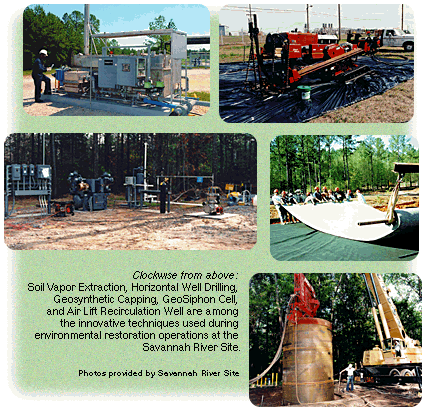| Innovative
technologies at work at SRS 
The Savannah River Site
is using a number of innovative technologies in its
environmental restoration operations. Among them are Air
Lift Recirculation Wells, Soil Vapor Extraction,
Geosynthetic Capping, and the GeoSiphon Cell. According
to SRS Assistant Manager for Environmental Quality Tom
Heenan, the major driver for using these approaches is
cost savings. He points out, "You wouldn't try any
of these approaches if you weren't going to get it done
better or cheaper and usually both." Here's what
these technologies do.
Soil Vapor
Extraction
SRS installed six Soil Vapor Extraction
units at the A/M Area between 1995 and 1997. These units
remove chlorinated volatile organic compounds in the
vadose zone before they move downward into the water
table. The vacuum units, which are connected to either
horizontal or vertical wells placed into contaminated
sources, withdraw contaminant vapors from the subsurface.
The vapors pulled from the subsurface flow to a thermal
treatment unit that destroys the contaminants using
catalytic oxidation.
The Soil Vapor Extraction units have increased the
removal rate of organic solvent by 500 percent over the
existing aboveground air stripper units that can remove
contaminants only from ground water. Heenan says the life
cycle cost benefit of the units is estimated to be $30
million.
Air Lift Recirculation Wells
Another innovative technology that SRS
uses at the A/M Area is Air Lift Recirculation Wells,
which are essentially in situ air strippers. This
technology uses two concentric well pipes with upper and
lower baffles and screens. Air is pumped down the center
well, and then it moves up the outer well carrying with
it chlorinated volatile organic compounds. The
recirculating flow of air brings more ground water into
the well to be cleaned. This method is half the cost of
aboveground air stripping.
Geosynthetic Closure Cap
SRS installed the first Geosynthetic Cap
approved by the state of South Carolina at its
Nonradioactive Disposal Facility (also known as the
Sanitary Landfill). The technique had been used
elsewhere, but through some applications engineering, it
was modified for use at SRS. Geosynthetic Caps are an
improvement over conventional kaolin clay cap closures
because of flexibility and ease of installation, which
shorten installation and construction time. A
Geosynthetic Closure Cap consists of seven layers:
foundation layer, reinforcement layer, gas vent layer,
geosynthetic clay liner, flexible membrane layer,
geosynthetic drainage layer, and vegetative layer.
According to Heenan, SRS estimates it has 500 acres to
cap, half of which are suitable for Geosynthetic Capping.
Heenan says the estimated cost savings of using
Geosynthetic Caps is $100,000 per acre.
GeoSiphon Cell
Heenan calls the GeoSiphon Cell this
year's "gee whiz." It is being evaluated for in
situ treatment of chlorinated volatile organic compounds
in ground water at the TNX Area at the site. It is
suitable for sites with shallow contamination. The
Geosiphon Cell is a large- diameter well that can be
packed with treatment media such as granular cast iron.
Hydraulic pressure induced by the natural hydraulic head
difference between the cell and the Savannah River draws
contaminated ground water through the treatment cell. The
solvent contaminants are reduced to ethane, methane, and
chloride ions. The treated water, which meets Primary
Drinking Water Standards, is discharged into the Savannah
River.
For more information about these and other
technologies used in cleanup at SRS, view the Web site at
http://www.srs.gov.
Information is organized under both the
"Technology" and the "Environment"
areas on the Web site.
|

